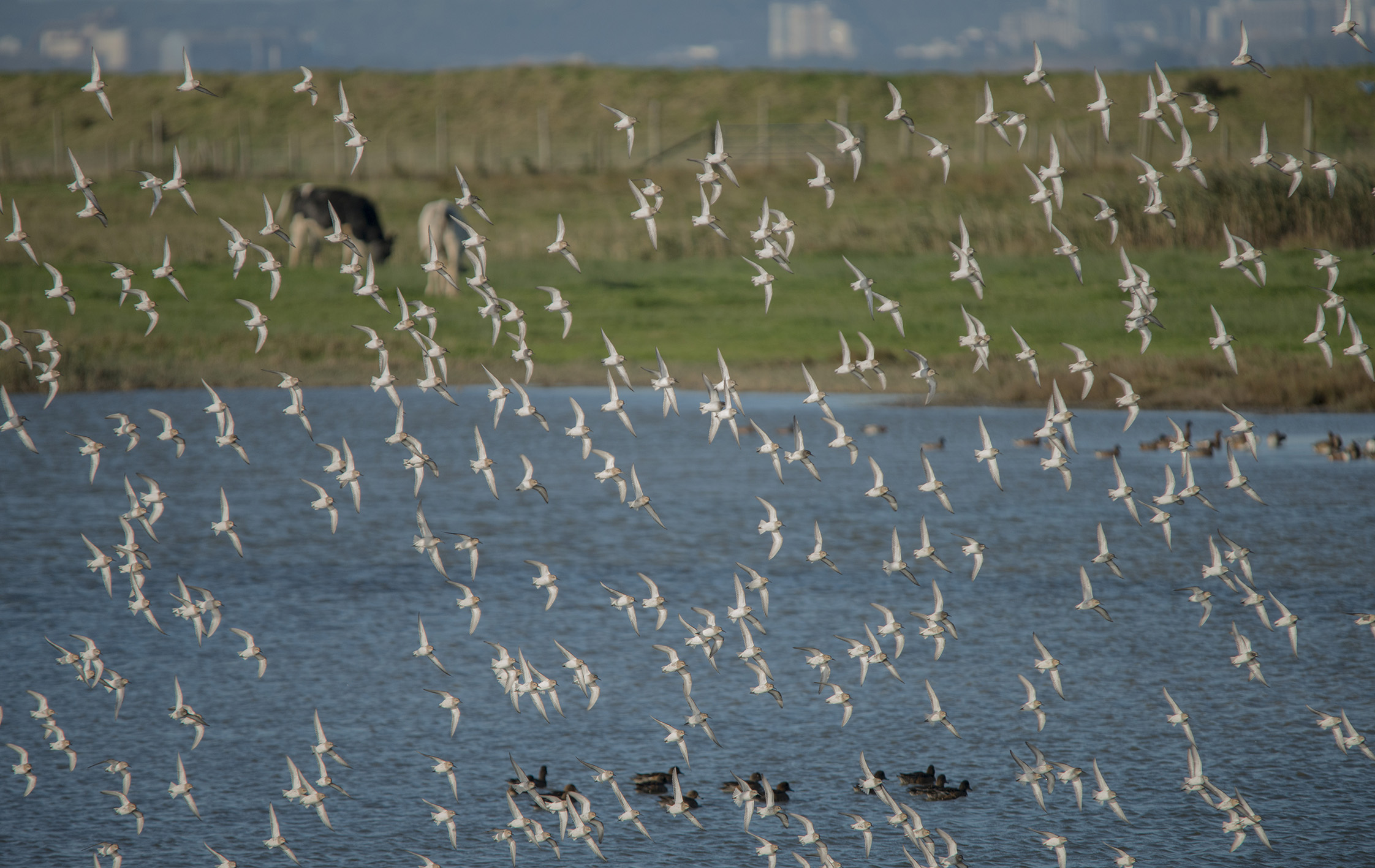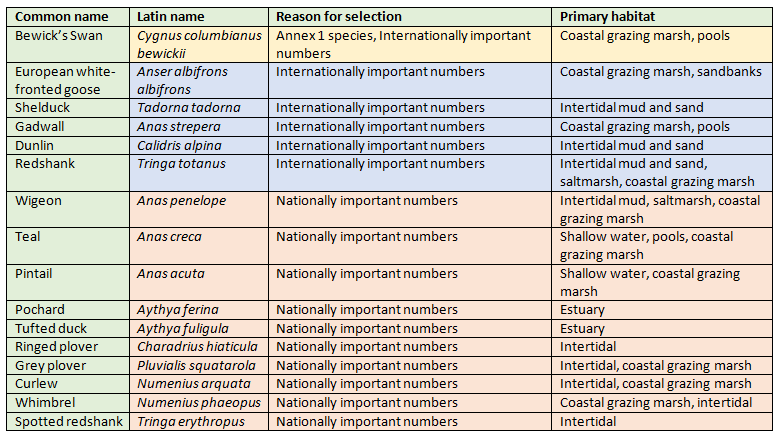Birds
The Severn Estuary is internationally important for its wading birds and wildfowl. The species in this section are all features for which the Severn Estuary is designated as a SSSI, SAC, SPA and Ramsar.
The migratory wintering and passage populations of birds of the Severn Estuary SPA and Ramsar site support over 70,000 birds in winter, including species of both national and international importance. In addition, the entire assemblage of waterfowl (wildfowl and waders) is a feature of the SPA and Ramsar site and is also a notable sub-feature of the ‘Estuaries’ feature of the SAC.
Table 1. Summary table of designated bird features of the Severn Estuary SPA and Ramsar site. Adapted from English Nature, Severn Estuary Natural Area Profile (1997).
SPA – Internationally Important Population of Regularly Occurring Annex 1 Species

© Peter Orr
SPA Interest Feature 1: Bewick’s Swan – Cygnus columbianus bewickii
The Bewick’s Swan population on the estuary is of international importance, listed as an Annex 1 species under the EC Birds Directive (2009/147/EC). Key supporting habitats for the Bewick’s Swan are intertidal mud and sand flats and saltmarsh, especially those in the upper reaches of the estuary which are important for feeding and roosting. The Bewick’s Swan arrives in the estuary in October from its breeding grounds in Siberia and can be sighted in the Severn Estuary until March.
SPA – Internationally Important Population of Regularly Occurring Migratory Bird Species
SPA Interest Feature 2: European White-Fronted Goose – Anser albifrons albifronsEuropean white-fronted geese overwinter on the Severn, the birds usually arriving on the estuary in October. European white-fronted geese roost at night on the estuary sandbanks and feed during the day on saltmarshes, permanent pastures and other farmland. The sandbanks adjacent to the New Grounds at Slimbridge are a long-established and traditional wintering area, also using Waveridge Sand, Frampton Sand and the Noose. |
SPA Interest Feature 3: Dunlin – Calidris alpinaDunlin are small wading birds found mostly on the mid-shore areas of the estuary. It feeds in flocks during the winter, sometimes numbering thousands, roosting on nearby fields, saltmarshes and the shore when the tide is high. They primarily feed on invertebrates in the muddier and finer sediments, with particular concentrations at Rhymney/Peterstone, Uskmouth, Welsh Grounds and Bridgwater Bay. The Severn Estuary has the third largest wintering population of Dunlin in Britain. |
SPA Interest Feature 5: Shelduck – Tadorna tadornaShelduck exploit the rich resources of invertebrates found in the intertidal mudflats. They feed in groups and are distributed widely across the estuary around areas of extensive intertidal mudflats. There are particular concentrations on Bridgwater Bay and around the mouth of the River Rhymney. Bridgwater Bay is one of the largest moulting areas during late summer and autumn for shelduck in Europe. |
SPA Interest Feature 6: Gadwall – Anas streperaAlthough the gadwall population is a qualifying feature of the Severn Estuary SPA, they are not primarily found within the European Marine Site; gadwall are most notably found at the freshwater wetlands at Slimbridge and Bridgwater Bay. However, they can be found making use of the estuary at sites where freshwater flows into the estuary (i.e. rivers and large pills), particularly at Avonmouth, between the Severn crossings and at Woodspring and Weston Bays. |

Dunlin © John Coleman
SPA – Internationally Important Assemblage of Waterfowl
Species that qualify as a component of the assemblage feature include all the birds in the section above, as well as those species which have nationally important populations.
| Bewick’s Swan (description above) | Wigeon | Ringed plover |
| Dunlin (description above) | Whimbrel | Grey plover |
| Redshank (description above) | Teal | Curlew |
| European white-fronted goose (description above) | Pintail | Spotted redshank |
| Shelduck (description above) | Pochard | Tufted duck |
| Gadwall (description above) |

Redshank; pochard; whimbrel; tufted duck © John Coleman
| Wigeon – Anas Penelope
The Severn Estuary supports a population of almost 4,000 wigeon, which accounts for 1.6% of the population in Great Britain. They are found in the upper reaches of the estuary, in areas of well-grazed salt marsh and salt pans. Eel grass beds also provide a food source for grazing wildfowl species like wigeon. |
Teal – Anas crecca
The Severn Estuary supports a teal population of almost 2,000, which accounts for around 2% of the population in Great Britain. Teal are widely distributed across the estuary and, in winter, can be found feeding on the seeds of saltmarsh plants, such as Salicornia sp. |
| Pintail – Anas acuta
Pintail are widely distributed across the estuary, with notable concentrations at New Grounds and at Peterstone/Rhymney. The overwintering birds arrive to feed on the seeds of saltmarsh plants from September, with numbers peaking in December. Their return migration takes place from late February into March. |
Pochard – Aythya ferina
The Severn Estuary supports a pochard population of almost 1,700 birds, which accounts for approximately 3.8% of the population in Great Britain. New Grounds hosts a high population density of pochard during the daytime, with others feeding and resting at Peterstone and the mouth of the Rhymney. Large numbers of Pochard migrate onto the estuary in periods of sustained cold weather. |
| Tufted duck – Aythya fuligula
The tufted duck population feed on molluscs, insects and some plants. The Severn Estuary supports a tufted duck population of around 1,000 birds, which accounts for around 1.5% of the population in Great Britain. Tufted ducks predominantly group together during the day at New Grounds, with the majority of others congregating at Peterstone and the mouth of the Rhymney. |
Ringed plover – Charadrius hiaticula
Ringed plover feed on the rich invertebrate fauna associated with decomposing seaweed, which occurs along undisturbed strandlines. The Severn Estuary supports a ringed plover population of over 200 birds, which accounts for around 1.0% of the population in Great Britain. There are large overwintering populations of the ringed plover on the Severn, populations increasing in the spring and autumn when they are passing through the estuary on their migrations to and from Europe, Greenland and Canada. |
| Grey plover – Pluvialis squatarola
The Severn Estuary supports a population of over 700 grey plovers, which accounts for approximately 3.7% of the population in Great Britain. Its primary habitats are intertidal and coastal grazing marsh. Dense populations of grey plover are located between Peterstone and the Newport Wetlands Reserve. |
Curlew – Numenius arquata
The Severn Estuary supports a population of over 3,000 curlew, which accounts for approximately 3.4% of the population in Great Britain. Dense populations of curlew can be found on the mudflats near the first Severn Bridge, as well as Bridgwater Bay and the Welsh Grounds. Curlew feed on the saltmarshes across the estuary. |
| Whimbrel – Numenius phaeopus
The estuary is particularly important for whimbrel during their passage periods in the spring and the autumn. The Severn Estuary supports a population of over 200 whimbrel (4.9% of the population in Great Britain) during their spring passage. The birds feed on the mudflats and have major night roosts at Collister Pill and Stert Island; the Stert Island roost is the largest of its kind in Britain. |
Spotted redshank – Tringa erythropus
The Severn Estuary supports a small, but significant population of spotted redshank, accounting for around 1.5% of the population in Great Britain. Spotted redshank are predominantly found around Stert Island and, occasionally, in the Axe and Yeo estuaries.
|

Ringed plover; wigeon; curlew; shelduck © John Coleman
For more information, see the Severn Estuary Regulation 33 Conservation Advice.

